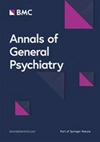卡塔尔精神病患者的死亡率:一项回顾性队列研究
IF 3.6
3区 医学
Q1 PSYCHIATRY
引用次数: 0
摘要
有大量证据表明,精神病患者的死亡率高于普通人群。然而,大多数研究都来自西方国家,尚不清楚这一结论是否也适用于像卡塔尔这样的阿拉伯国家。我们旨在探索卡塔尔精神病患者的死亡率是否与非精神病患者不同。我们利用哈马德医疗公司(HMC)殡仪馆登记的死亡名单开展了一项回顾性队列研究,其中包括 2017 年和 2018 年死亡的所有卡塔尔国民。我们将死者队列分为两组:患有精神疾病和未患有精神疾病。对于每个组别,我们都收集了死亡时的年龄、报告的死因以及社会人口学和临床数据。2017 年登记的死亡人数为 602 人,2018 年为 589 人。精神病发病率为20.4%。与没有精神疾病的受试者相比,患有精神疾病的受试者的死亡年龄竟然更高(中位数±IQR = 76.5 ± 22.1 岁 vs. 62.7 ± 32.9 岁;p < .001)。即使在控制了协变量后,这一差异依然存在。精神病患者更有可能死于感染(OR = 1.98[1.44;2.71])或慢性呼吸系统疾病(OR = 3.53 [1.66;7.52]),但死于意外(OR = 0.21[0.09;0.49])或先天性原因(OR = 0.18[0.04;0.77])的可能性较小。与之前的大多数研究相反,我们并没有发现患有精神疾病的卡塔尔人死亡率更高。社会文化因素、免费且容易获得的医疗保健服务以及精神卫生专业人员在发现合并症方面发挥的更大作用可能是这一发现的原因。本文章由计算机程序翻译,如有差异,请以英文原文为准。
Mortality in Qatari individuals with mental illness: a retrospective cohort study
There is substantial evidence that people with mental illness have higher mortality rates than the general population. However, most of the studies were from Western countries, and it is not clear whether this finding also applies to Arab countries like Qatar. We aimed to explore whether mortality in patients with mental illness in Qatar, is different from those without. We conducted a retrospective cohort study, including all Qatari nationals deceased in 2017 and 2018, using the list of registered deaths from Hamad Medical Corporation (HMC) Mortuary. We divided the cohort of deceased people into two groups: with and without mental illness. For each of the groups, we collected the age at death, the reported cause of death as well as sociodemographic and clinical data. There were 602 registered deaths in 2017 and 589 deaths in 2018. The prevalence of mental illness was 20.4%. Compared to subjects without mental illness, subjects with mental illness surprisingly had higher age at death (median ± IQR = 76.5 ± 22.1 years vs. 62.7 ± 32.9 years; p < .001). This difference persisted even after we controlled for covariates. Individuals with mental illness were more likely to die of an infection (OR = 1.98[1.44;2.71]), or of chronic respiratory disease (OR = 3.53 [1.66;7.52]) but less likely to die because of accidental (OR = 0.21[0.09;0.49]) or congenital causes (OR = 0.18[0.04;0.77]). Contrary to most previous studies, we did not find that mortality was higher in Qatari individuals with mental illness. Sociocultural factors, free and easy-to-access healthcare, and an enhanced role of mental health professionals in detecting medical comorbidities may explain this finding.
求助全文
通过发布文献求助,成功后即可免费获取论文全文。
去求助
来源期刊

Annals of General Psychiatry
PSYCHIATRY-
CiteScore
6.60
自引率
2.70%
发文量
43
审稿时长
>12 weeks
期刊介绍:
Annals of General Psychiatry considers manuscripts on all aspects of psychiatry, including neuroscience and psychological medicine. Both basic and clinical neuroscience contributions are encouraged.
Annals of General Psychiatry emphasizes a biopsychosocial approach to illness and health and strongly supports and follows the principles of evidence-based medicine. As an open access journal, Annals of General Psychiatry facilitates the worldwide distribution of high quality psychiatry and mental health research. The journal considers submissions on a wide range of topics including, but not limited to, psychopharmacology, forensic psychiatry, psychotic disorders, psychiatric genetics, and mood and anxiety disorders.
 求助内容:
求助内容: 应助结果提醒方式:
应助结果提醒方式:


